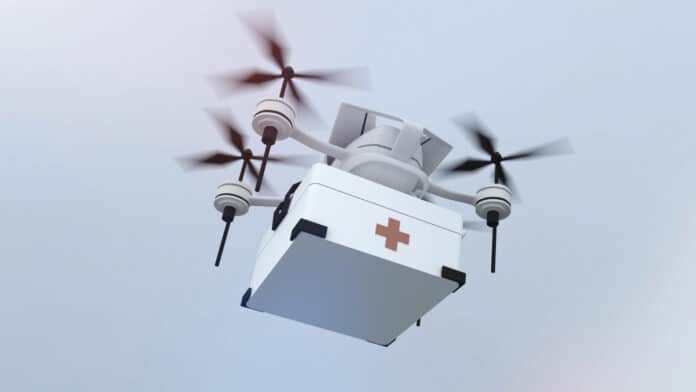Sudden cardiac arrest is a serious medical emergency in which your heart suddenly stops beating. This happens when an electrical issue makes your heart stop pumping blood, leading to a lack of blood flow and oxygen to the body’s cells. Unfortunately, sudden cardiac arrest can be fatal within a few minutes if not treated immediately. Survival in cases of out-of-hospital cardiac arrest is low globally; only 10% of people survive.
An early shock with an automated external defibrillator (AED) can dramatically increase a person’s chances of survival. While there are tens of thousands of AEDs available in the community, they are not typically found in people’s homes, where most cardiac arrests occur. During the past decade, the idea of drones delivering AEDs has arisen, and several studies on this subject have been done.
To shorten the time to defibrillation with an AED, Karolinska Institutet, together with Region Västra Götaland, SOS Alarm, and the drone operator Everdrone, has been testing the use of drones that carry AEDs since 2020. By sending out a drone with an AED simultaneously with an ambulance being alerted, the goal is to shorten the time it takes to reach a patient in need.
The project has been implemented in an area of approximately 200,000 people in western Sweden, and an initial study conducted in the summer of 2020 in Gothenburg and Kungälv showed that the idea was feasible and safe.
The researchers found that in more than half of the cases, the drones were ahead of the ambulance by an average of three minutes. Also, in the majority of cases where the patient was in cardiac arrest, the drone-delivered defibrillator was used to stop the condition from getting worse or leading to death.
“This more comprehensive and follow-up study now shows in a larger material that the methodology works throughout the year, summer and winter, in daylight and darkness. Drones can be alerted, arrive, deliver AED, and people on site have time to use the AED before the ambulance arrives,” says Sofia Schierbeck, PhD student at the same department and first author of the study.
A recent prospective observational study conducted in Sweden involved dispatching five AED-equipped drones alongside standard emergency medical services for suspected out-of-hospital cardiac arrests. The drones were placed within two controlled airspaces and operated autonomously.
The study compared the AED delivery time of drones and ambulances in 55 cases of suspected cardiac arrest. Surprisingly, in 37 of these cases, the drones arrived faster than the ambulances, which accounts for 67% of the total cases, with a median lead time of 3 minutes and 14 seconds. Out of the 18 cases of actual cardiac arrest, the caller managed to use the drone-delivered AED in six cases, which represents 33%. Shock was recommended by the device in two cases, with one person achieving 30-day survival.
“Our study now shows once and for all that it is possible to deliver AED with drones and that this can be done several minutes before the arrival of the ambulance in connection with acute cardiac arrest,” says Andreas Claesson. “This time saving meant that the healthcare emergency center could instruct the person who called the ambulance to retrieve and use the AED in several cases before the ambulance arrived.”
Journal reference:
- Sofia Schierbeck, Anette Nord, Leif Svensson, Mattias Ringh, Per Nordberg, Prof Jacob Hollenberg, Peter Lundgren, Fredrik Folke, Martin Jonsson, Sune Forsberg, Andreas Claesson. Drone delivery of automated external defibrillators compared with ambulance arrival in real-life suspected out-of-hospital cardiac arrests: a prospective observational study in Sweden. The Lancet Digital Health, 2023; DOI: 10.1016/S2589-7500(23)00161-9
